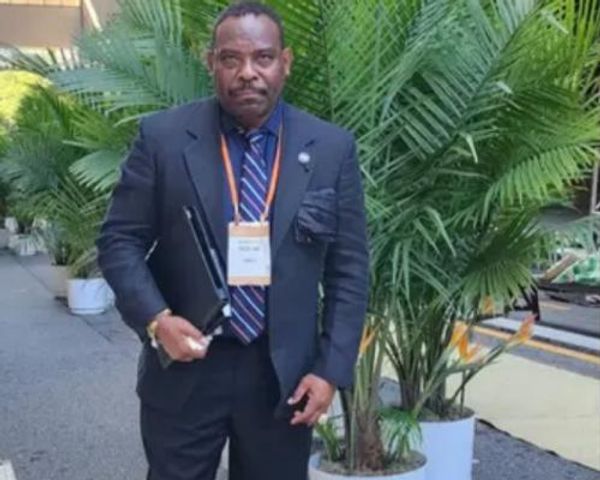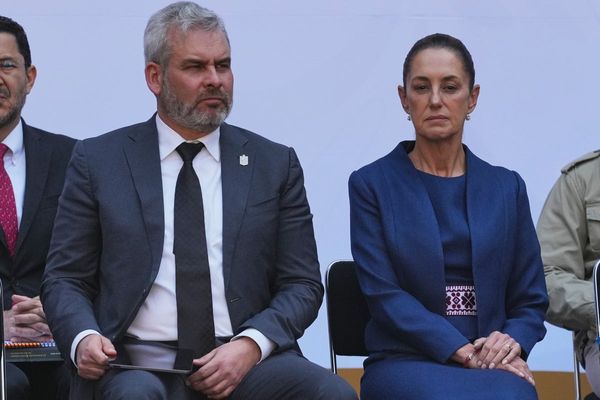
In NASCAR's summer Cup race at Daytona in 2023, Ryan Preece took a terrifying flip through the grass, luckily walking away from the airborne incident with only minor injuries. The sport — and Daytona International Speedway — reacted quickly, repaving the area of the backstretch leading into the turn officially known as Le Mans chicane, but still popularly called Bus Stop.
Since then, more changes have been made. The grass is gone and the curbing has been reshaped and raised, making for a tighter corner. And in the eyes of some drivers, the iconic corner at Daytona is a lot less fun now.
After a week of practice and setup, just before the green flag drops, it's looking like Bus Stop could be as big a factor in the race as ever.
A bit like a "parking lot"
Matt Campbell, the defending overall winner at the Rolex 24, gets why the changes were made — he's just not sure they'll make for better racing.
"There's been slight adjustments every single year that I've been a part of it, but this year is the most change," Campbell told Motorsport. "I think there's good aspects and bad aspects. From a runoff point of view, it's maybe a little bit safer and easier to avoid a bad situation or incident but certainly it's taken away a little bit of the enjoyment factor because it's a little bit slower, a little bit tighter. It looks like a little bit of a parking lot."
Campbell, set to make his seventh consecutive appearance at the Rolex 24, isn't alone in that diagnosis. It's more than just lamenting the aesthetics, his Porsche Penske teammate Mathieu Jaminet, the 2022 GTD Pro class winner at Daytona, explains.
"If you have no cars in front of you [at night], you just arrive and go, 'Where's the corner?'" said Jaminet. "You don't see any green part anymore, so it's really made it challenging for the driver."

Jaminet said that the curbing has made the corner feel slower, and that the changes "slightly killed the flow towards the exit... Let's say, the second part of the chicane."
He's not against the new challenge that the updated Bus Stop offers, and has a glass-half-full take. As Jaminet put it, the updated version "requires now a bit more skills from the driver." He thinks that could be a good thing. "It's not that easy to go through."
A bigger risk factor
If Jaminet could make a suggestion, the French driver wishes Daytona International Speedway would have kept the grass. While the move was made to make NASCAR racing safer on the high banks, it might embolden drivers to attempt riskier overtakes in the Rolex 24.
"Do the same layout but with grass around," he said. "I think we would avoid some cutting here and there. Now I feel like people are more content to try some crazy overtakes, because they feel like there's going to be runoff left and right. And this is not what you want to see, because there could be some big crashes going in there."
Both Jaminet and Campbell added that the new layout has made setting up the car trickier and has forced drivers to adjust their line, especially when calculating how much curb to take. The old curbing was generous; the new version forces drivers to be more cautious lest the car jump out from beneath them.
Jaminet believes that Bus Stop — or what's left of it — is the most important corner on the 12-turn, 3.56-mile road course, and for good reason. Plenty of finales have come down to this famous corner after 24 hours of tight racing, which sets up the final line through the line. And managing the updated version may make the difference between the winners and losers in this year's Rolex 24.
Photos from the Saturday of Daytona 24 Hours

2025 Daytona 24 Hours - Saturday

2025 Daytona 24 Hours - Saturday

2025 Daytona 24 Hours - Saturday

2025 Daytona 24 Hours - Saturday

2025 Daytona 24 Hours - Saturday

2025 Daytona 24 Hours - Saturday

2025 Daytona 24 Hours - Saturday

2025 Daytona 24 Hours - Saturday

2025 Daytona 24 Hours - Saturday

2025 Daytona 24 Hours - Saturday

2025 Daytona 24 Hours - Saturday

2025 Daytona 24 Hours - Saturday

2025 Daytona 24 Hours - Saturday

2025 Daytona 24 Hours - Saturday

2025 Daytona 24 Hours - Saturday

2025 Daytona 24 Hours - Saturday

2025 Daytona 24 Hours - Saturday

2025 Daytona 24 Hours - Saturday

2025 Daytona 24 Hours - Saturday

2025 Daytona 24 Hours - Saturday

2025 Daytona 24 Hours - Saturday

2025 Daytona 24 Hours - Saturday

2025 Daytona 24 Hours - Saturday

2025 Daytona 24 Hours - Saturday

2025 Daytona 24 Hours - Saturday

2025 Daytona 24 Hours - Saturday

2025 Daytona 24 Hours - Saturday

2025 Daytona 24 Hours - Saturday

2025 Daytona 24 Hours - Saturday

2025 Daytona 24 Hours - Saturday

2025 Daytona 24 Hours - Saturday

2025 Daytona 24 Hours - Saturday

2025 Daytona 24 Hours - Saturday

2025 Daytona 24 Hours - Saturday

2025 Daytona 24 Hours - Saturday

2025 Daytona 24 Hours - Saturday

2025 Daytona 24 Hours - Saturday

2025 Daytona 24 Hours - Saturday

2025 Daytona 24 Hours - Saturday

2025 Daytona 24 Hours - Saturday

2025 Daytona 24 Hours - Saturday

2025 Daytona 24 Hours - Saturday

2025 Daytona 24 Hours - Saturday

2025 Daytona 24 Hours - Saturday

2025 Daytona 24 Hours - Saturday

2025 Daytona 24 Hours - Saturday

2025 Daytona 24 Hours - Saturday

2025 Daytona 24 Hours - Saturday

2025 Daytona 24 Hours - Saturday

2025 Daytona 24 Hours - Saturday

2025 Daytona 24 Hours - Saturday

2025 Daytona 24 Hours - Saturday

2025 Daytona 24 Hours - Saturday

2025 Daytona 24 Hours - Saturday

2025 Daytona 24 Hours - Saturday

2025 Daytona 24 Hours - Saturday

2025 Daytona 24 Hours - Saturday

2025 Daytona 24 Hours - Saturday

2025 Daytona 24 Hours - Saturday

2025 Daytona 24 Hours - Saturday

2025 Daytona 24 Hours - Saturday

2025 Daytona 24 Hours - Saturday

2025 Daytona 24 Hours - Saturday

2025 Daytona 24 Hours - Saturday

2025 Daytona 24 Hours - Saturday

2025 Daytona 24 Hours - Saturday

2025 Daytona 24 Hours - Saturday

2025 Daytona 24 Hours - Saturday

2025 Daytona 24 Hours - Saturday

2025 Daytona 24 Hours - Saturday

2025 Daytona 24 Hours - Saturday

2025 Daytona 24 Hours - Saturday

2025 Daytona 24 Hours - Saturday

2025 Daytona 24 Hours - Saturday

2025 Daytona 24 Hours - Saturday

2025 Daytona 24 Hours - Saturday

2025 Daytona 24 Hours - Saturday

2025 Daytona 24 Hours - Saturday

2025 Daytona 24 Hours - Saturday

2025 Daytona 24 Hours - Saturday

2025 Daytona 24 Hours - Saturday

2025 Daytona 24 Hours - Saturday

2025 Daytona 24 Hours - Saturday

2025 Daytona 24 Hours - Saturday

2025 Daytona 24 Hours - Saturday

2025 Daytona 24 Hours - Saturday

2025 Daytona 24 Hours - Saturday

2025 Daytona 24 Hours - Saturday

2025 Daytona 24 Hours - Saturday

2025 Daytona 24 Hours - Saturday

2025 Daytona 24 Hours - Saturday








